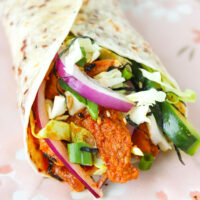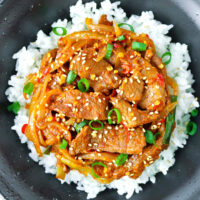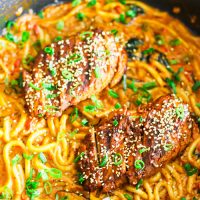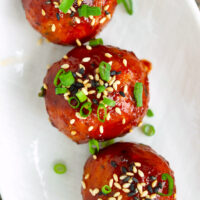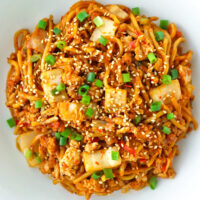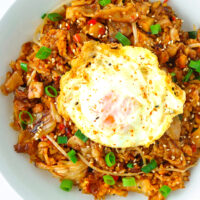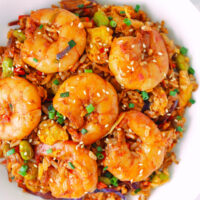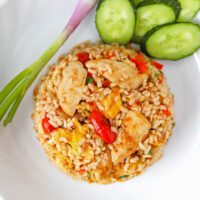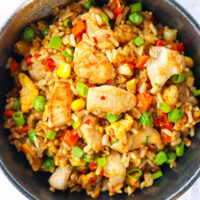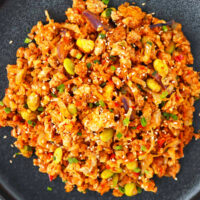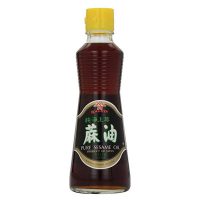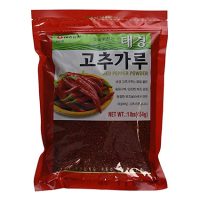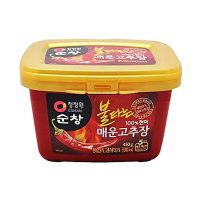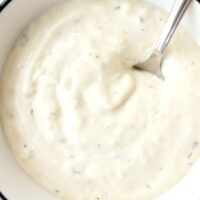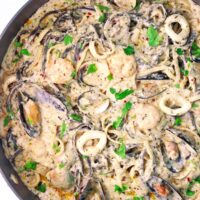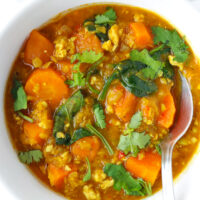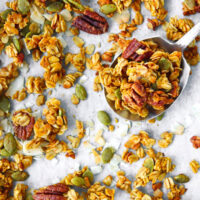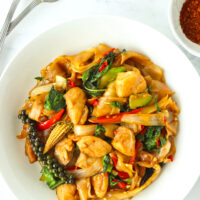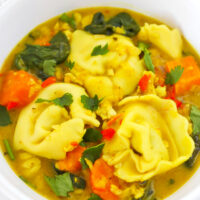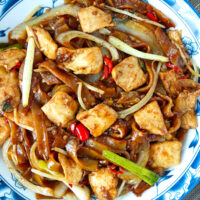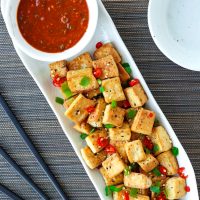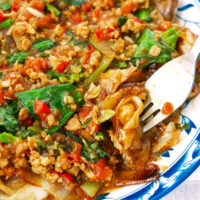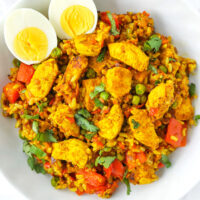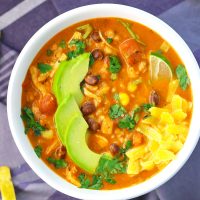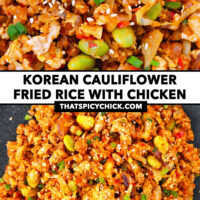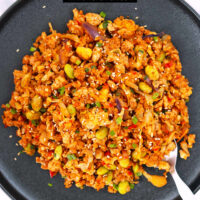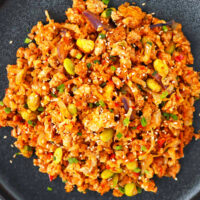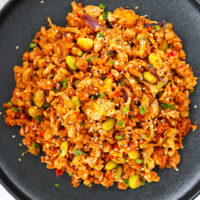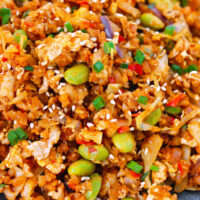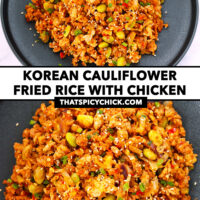Korean Cauliflower Fried Rice
This post contains affiliate links.
This Korean Cauliflower Fried Rice is quick and easy to make in one wok and full of BIG and BOLD flavors! Ground chicken, cauliflower rice, fragrant aromatics, scrambled eggs and veggies get tossed with spicy-smoky gochujang and other Korean-style seasonings! It’s ready in 30 minutes, high in protein, filling and DELICIOUS!
Spicy Korean Cauliflower Fried Rice with gochujang and soy sauce infused ground chicken, fluffy scrambled eggs, plenty of garlic and chilies, edamame, shredded tri-color slaw mix with carrots and red and green cabbage, cauliflower rice and a drizzle of toasted sesame oil for that intoxicating toasted sesame aroma! If that sounds delicious to you than you NEED this Korean-inspired healthy fried rice in your life!
This dish ticks all the right boxes in my books. It’s:
- Healthy.
- Quick, easy and convenient to make.
- Not messy and doesn’t require making cauliflower rice from scratch.
- DELICIOUS!
- High in protein and fiber and will keep you full and satisfied for hours!
While several people will say the texture is better when you make the cauliflower rice from scratch by cutting up a whole cauliflower and blending florets in a food processor, I believe that you can still make an amazing non-mushy cauliflower fried rice using frozen store-bought frozen cauliflower rice. All you need is a bit of technique during stir-frying and HIGH heat.
So whip out your wok and let me show you how to make this easy, nutritious and convenient Korean Cauliflower Fried Rice!

Why This Recipe Works
- Quick and easy. All you need is one wok and this dish is on the table in 30 minutes!
- Convenient. Using ground chicken saves time as you don’t need chop up any cuts of meat. Using store-bought frozen shelled edamame, frozen cauliflower rice as well as a pre-packaged tri-color slaw mix also shaves off minutes of prep and cleanup time!
- AMAZING flavors. It’s spicy and smoky thanks to gochujang and boasts a hint of tang and sweetness! It’s a party in your mouth!
- Great texture. High heat and using the flattening, pausing and stir-frying technique yields an fantastic non-soggy cauliflower fried rice.
- Meal prep friendly. You can double the ingredients and make 4 servings to enjoy for lunch or dinner throughout the week.
Keep in Touch!
Subscribe to get new posts via email:
Ingredient Notes and Substitutes
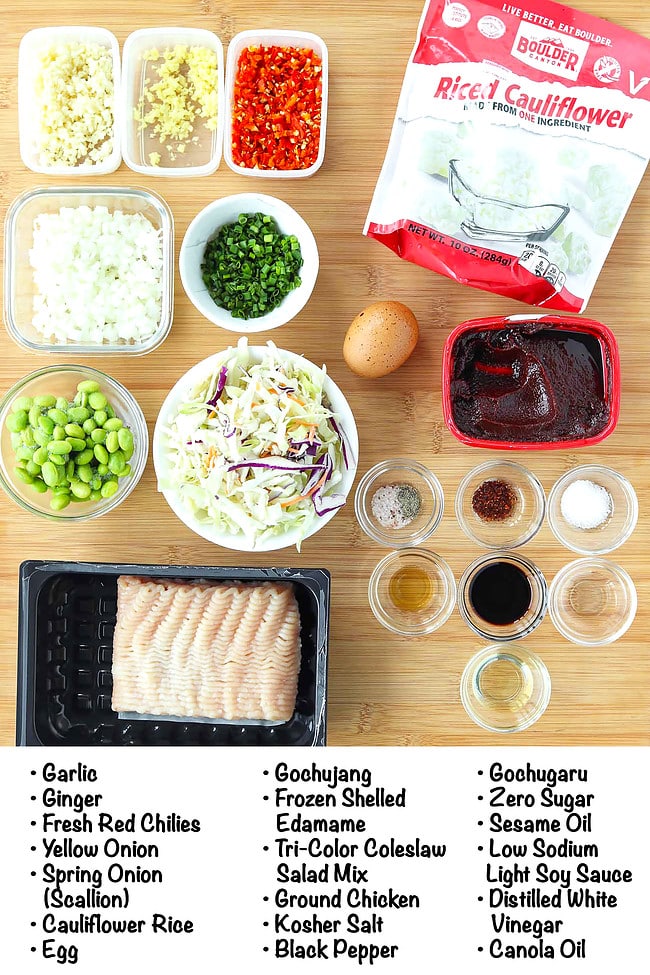
- Aromatics: Some garlic, ginger, red chilies, and spring onion (green onion/scallion). I used Thai Bird’s Eye chilies which are quite spicy. Feel free to use any type of red chilies you love and adjust the quantity to taste based on your heat level preference.
- Veggies: I used yellow onion, frozen shelled edamame, and tri-color coleslaw salad mix (red and green cabbage and carrots) for convenience. You can use sliced carrots and cabbage if a pre-packaged sliced slaw mix isn’t easily available to you. See the ‘Variations’ section below for other veggie ideas to use in this Korean cauliflower fried rice.
- Eggs: Because fried rice always tastes better with fluffy scrambled eggs. If you’re not a fan of eggs leave them out.
- Cauliflower Rice: I used store-bought frozen cauliflower rice which can be found in the freezer section of most mainstream supermarkets. It’s convenient, less messy than making your own and using it still yields a delicious and great textured cauliflower fried rice. You’re welcome to make the cauliflower rice yourself by pulsing fresh cauliflower florets in a food processor if you prefer.
- Lean Ground Chicken: We’ll be using ground chicken so we can skip cutting our meat. Feel free to use any ground meat protein you love or crumbled firm tofu.
- Gochujang: This is a fermented Korean red chili pepper paste that comes in small tubs. It’s loaded with umami and has a spicy-sweet and smoky flavor. I use an extra spicy gochujang from Chung Jung One brand in my home, but a regular spice level gochujang works too. These days, you can find gochujang in the Asian section of most mainstream supermarkets that are well-stocked with international ingredients. If not, try an Asian or Korean supermarket or purchase it online.
- Granulated Sugar-Free Sweetener: I added a pinch of Wholesome Zero Sugar to balance out the spicy flavors. It’s a sugar-free and calorie-free erythritol based sweetener. You can use any other sugar-free sweeteners made from stevia, monk fruit, etc. Or use regular granulated white sugar or pure maple syrup, coconut sugar, or honey or if you prefer.
- Gochugaru: This is a hot Korean pepper powder and can be found in Asian and Korean supermarkets as well as online. Use more or less to taste or leave it out for a milder flavor. Substitute with chili powder if unavailable.
Full ingredient list and amounts are in the recipe card below.
How to Make Korean Cauliflower Fried Rice
1. Cook the gochujang chicken. Heat oil in a large nonstick wok or heavy bottomed deep skillet Add the ground chicken and season with salt and pepper. Cook for a few minutes and break up the clumps using your spatula until no longer pink. Season with low sodium light soy sauce, gochujang and sesame oil. Mix well to combine until the meat is coated well in the sauces. Transfer to a clean bowl and set aside.

2. Stir-fry the aromatics. Add the remaining oil to the pan and stir-fry the yellow onion, spring onion white and light green parts and ginger until starting to soften. Then stir-fry the garlic and chilies until fragrant.
3. Add the veggies. Add the tri-color coleslaw salad mix and edamame and season with kosher salt and ground black pepper. Stir-fry until slightly softened.
4. Cook the eggs. Push everything to the side of the wok and pour in the eggs. Allow to set for a few seconds before breaking up into pieces and tossing with everything else.
5. Add the gochujang chicken. Add the cooked gochujang ground chicken and stir-fry to combine.

6. Add the cauliflower rice and seasonings. Add the cauliflower rice and seasonings and stir-fry for 2-3 minutes, pausing and flattening every few seconds, until no longer mushy and wet.
7. Toss through the spring onion. Drizzle sesame oil over the cauliflower fried rice and toss through the spring onion dark green parts.
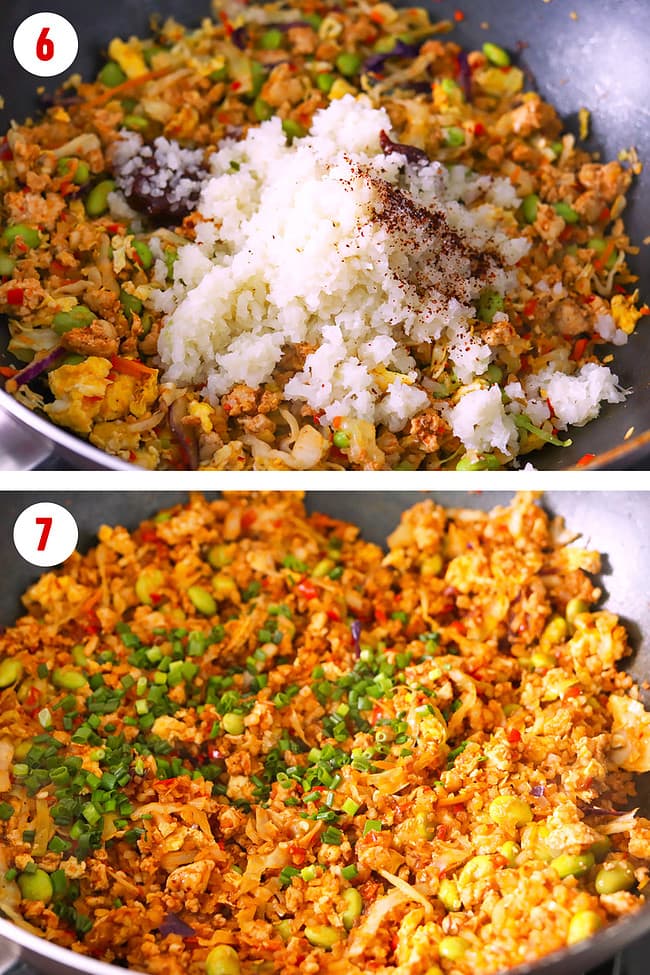
Serve! Divide evenly onto plates or in bowls and garnish with toasted white or black sesame seeds and more spring onion. Serve and enjoy!

Full detailed instructions are in the recipe card below.
Cook’s Tips
- Cook over high heat. It’s important to cook any type of fried rice over high heat so that it doesn’t steam and become mushy in the wok. It’s even more important in the case of cauliflower fried rice as it is a wet vegetable to begin with, especially if using frozen rice cauliflower.
- Use a pausing and flattening technique while stir-frying the riced cauliflower. By flattening the mixture occasionally with your spatula and pausing before stir-frying again, the heat from the hot wok will help cook the riced cauliflower and also cook off the excess water. This way the final cauliflower fried rice dish won’t end up mushy or wet.
- Adjust spice level to taste. Make it milder to suit your heat level preference by using less (or omitting) the fresh red chilies and gochugaru. Use a regular spice level gochujang (not extra spicy like the one I’ve used) and use slightly less if you are very sensitive to spice. Keep in mind this is meant to be a spicy fried rice and you don’t want to omit the gochujang as the flavor will be completely different and altered.
- Meal prep option. Double the ingredients and cook the cauliflower fried rice in two batches to make 4 servings. You can enjoy it for an easy lunch or dinner during the week.
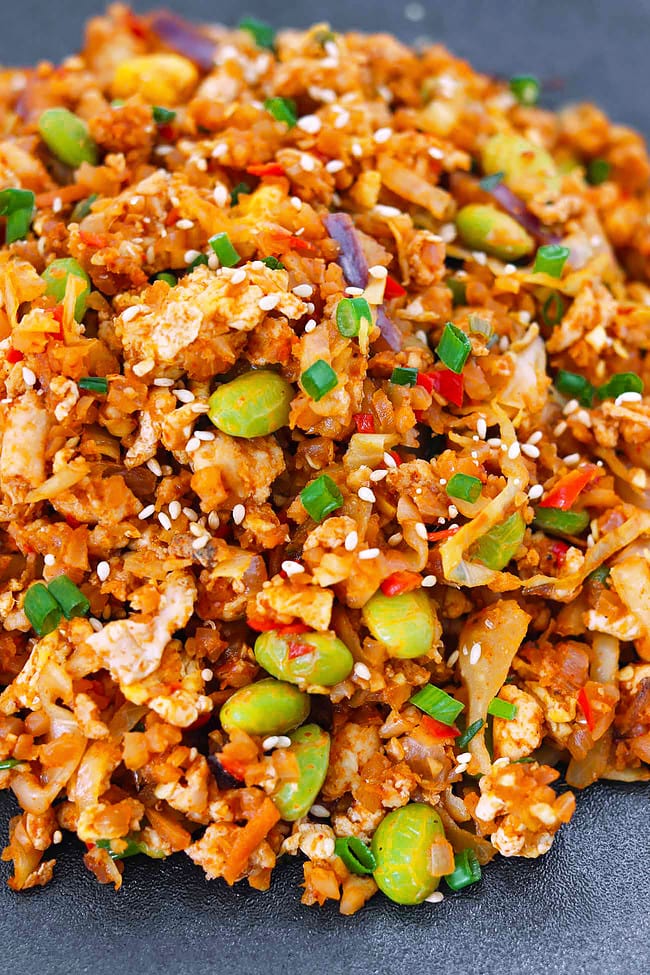
Variations
- Use a different ground protein. Lean ground beef, turkey or pork will taste great. If your pork is fatty, cook it first in a dry (unoiled) wok and drain off and discard the excess fat. Then mix through the salt, pepper and seasonings.
- Use different veggies. Any stir-fry friendly veggies will be tasty in this cauliflower fried rice. Some options are frozen mix veggies (thaw them first in the microwave), broccoli florets, broccolini, mung bean sprouts, sliced mushrooms, sliced or shredded brussels sprouts, green garden peas, zucchini, sugar snap peas, snow peas, bell pepper, etc.
- Make it gluten-free. Use a gluten-free low sodium light soy sauce and gochujang such as Wholly Gochujang.
- Make it vegetarian. Swap the ground chicken for a block of crumbled firm tofu or crispy pan-fried tofu cubes. You can cook the tofu the same way as the ground chicken. However, if using pan-fried tofu, add the seasonings and sauces you would have added to the chicken when you add the riced cauliflower to the wok.
- Make it vegan. Same as for making it vegetarian but leave out the egg too.
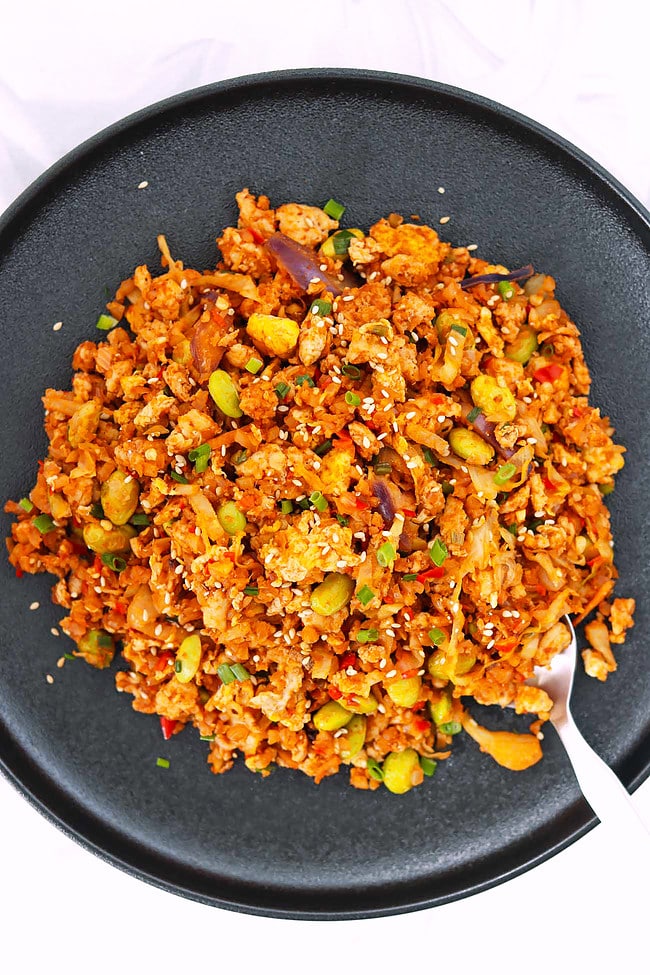
FAQs
Cauliflower rice and riced cauliflower are one and the same and can also be called cauliflower couscous. It’s cauliflower that has been broken down into small grains resembling rice either by pulsing in a food processor or shredding using a box grater. It is available in frozen bags too for convenience at most mainstream supermarkets.
Squeeze the bag gently to break apart pieces and evenly distribute the riced cauliflower. Be careful not to puncture the bag. Thaw the riced cauliflower in the microwave in its bag according to package instructions. Usually this involves microwaving the bag for 3-6 minutes on high but time may vary depending on the wattage of your microwave. Allow the bag to cool for 1 minute then carefully remove from the microwave. Use caution as the bag will be hot. Cut the bag open and pour the thawed riced cauliflower into a bowl. Spoon out and discard any excess water. It’s okay if the cauliflower rice is a little wet at this point as high heat will help cook off the excess liquid.
It is both nutrient dense and filling. It’s a great source of vitamin C and K and boasts a decent amount of fiber which helps keep you full, folate and vitamin B6. This cauliflower fried rice is incredibly filling because it’s high in protein since it also has lean ground chicken and other edamame.
Riced cauliflower is keto friendly because it’s low in carbohydrates and net carbs, and also a low-calorie food.
Gochujang is not keto and is high in carbs. You can use a keto friendly homemade gochujang or other hot pepper paste and use less or omit the edamame and tri-color slaw salad mix to make this fried rice more suitable for you if you are following a strict low carb keto diet.
Store in airtight sealed container(s) in the fridge and reheat on high in the microwave for 1-2 minutes, stirring halfway through, until hot throughout.
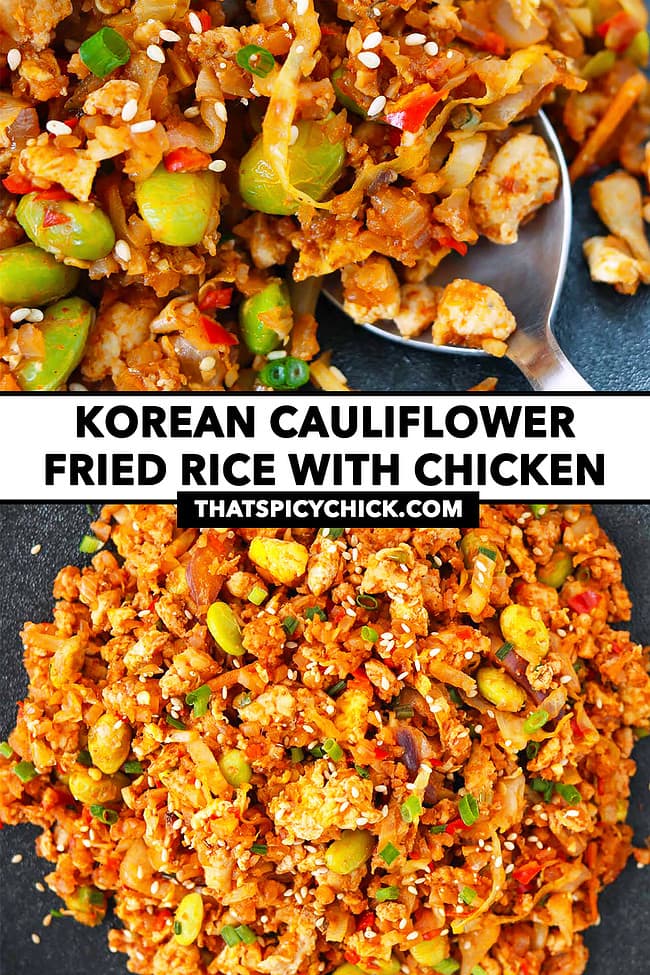
MADE THIS RECIPE? If you make this recipe, leave a comment below and let me know how you liked it! Take a photo and tag it with @thatspicychick on Instagram and hashtag it #thatspicychick and I’ll be sure to share your masterpiece!
STAY CONNECTED! You can also follow me on Pinterest, Facebook or Instagram. Sign up for my email list to get my latest recipe in your inbox weekly!
More Korean & Korean- Inspired Recipes
More Fried Rice
Korean Cauliflower Fried Rice
Korean Cauliflower Fried Rice is quick and easy to make and full of BIG and BOLD flavors! Ground chicken, cauliflower rice, fragrant aromatics, scrambled eggs and veggies get tossed with spicy-smoky gochujang and other Korean-style seasonings! It’s ready in 30 minutes, high in protein, filling and DELICIOUS!
- Prep Time: 20
- Cook Time: 10
- Total Time: 30 minutes
- Yield: 2 1x
- Category: Dinner
- Method: Stir-fry
- Cuisine: Korean-inspired
Ingredients
For the Gochujang Chicken:
- 1 TSP Peanut Oil (or any neutral oil with a high smoke point), for cooking
- 260 grams / 9 ounces Lean Ground Chicken
- ¼ + ⅛ TSP Kosher Salt, to taste
- ⅛ TSP ground Black Pepper
- ½ TBSP Low Sodium Light Soy Sauce
- ½ TBSP Gochujang (Korean chili pepper paste – note 1)
- ¼ TSP Sesame Oil
For the Korean Cauliflower Fried Rice:
- 50 grams / ¼ medium Yellow Onion – finely chopped
- 20 grams / 1 medium Spring Onion (Scallion/Green Onion) – finely chopped, white and light green parts separated from the dark green parts
- 8 grams / ≈ 1 TBLS minced Ginger
- 25 grams / 4-5 Garlic cloves – minced
- 35 grams / 9-10 fresh Red Chilies (Thai Bird’s Eye or any other small hot red chilies – note 2*), to taste – finely chopped
- 100 grams / 1 heaped cup Coleslaw Salad Mix (red and green cabbage and carrots – note 3)
- 100 grams / ⅔ cup Frozen Shelled Edamame, thawed
- 2 large Eggs – lightly beaten
- 226 grams / 8-ounce bag frozen Riced Cauliflower (about 2 cups) – thawed and drained if using frozen (note 4)
- ½ TBSP Peanut Oil
- ⅛ TSP ground Black Pepper, to taste
- ¼ TSP ground Kosher Salt, to taste
- 1 TBSP Low Sodium Light Soy Sauce
- 30 grams / 1 TBLS Gochujang
- 1 TSP Distilled White Vinegar
- ½ TSP granulated Sugar-Free Sweetener (I used Wholesome Zero Sugar – note 5)
- ¼ TSP Gochugaru (Korean hot pepper powder – note 6), to taste
- ½ TSP Sesame Oil
- To Serve: Toasted white or black sesame seeds, reserved chopped spring onion
Instructions
Prep:
- Prepare the fresh ingredients: Chop the yellow onion, spring onion (separating the white and light green parts from the dark green parts), ginger, garlic, and fresh red chilies as indicated in the ‘ingredients’ section. Measure out the slaw mix and shelled edamame. Thaw the frozen shelled edamame. Crack the eggs into a bowl and lightly beat.
- Prepare the frozen cauliflower rice: Squeeze the cauliflower rice bag gently to break apart pieces and evenly distribute the riced cauliflower. Be careful not to puncture the bag. Thaw the cauliflower rice in the microwave in its bag according to package instructions. Usually this involves microwaving the bag for 3-6 minutes on high but time may vary depending on the wattage of your microwave. Allow the bag to cool for 1 minute then carefully remove from the microwave. Use caution as the bag will be HOT. Cut the bag open and pour the thawed cauliflower rice into a bowl. Spoon out and discard any excess water. (It’s okay if the cauliflower rice is a little wet at this point as high heat will help cook off the excess liquid.)
For the Korean Cauliflower Fried Rice:
- Cook the gochujang chicken: Heat 1 teaspoon peanut oil in a large nonstick wok or heavy bottomed deep skillet over medium-high heat. Add the ground chicken and season with the (¼ + ⅛ TSP) kosher salt and (⅛ TSP) ground black pepper. Cook for 2 minutes, breaking the clumps until no longer pink. Add (½ TBSP) low sodium light soy sauce, (½ TBSP) gochujang and (¼ TSP) sesame oil. Mix well to combine until the meat is coated well in the sauces and cooked. Switch off the heat and transfer to a clean bowl.
- Stir-fry the aromatics: Heat the remaining (½ TBLS) peanut oil in the wok over high heat. Add the yellow onion, spring onion white and light green parts and ginger. Stir-fry for 30 seconds until the onion starts to soften. Add the garlic and chilies and stir-fry for another 30 seconds until fragrant.
- Add the veggies: Add the tri-color coleslaw salad mix and edamame. Season with ¼ TSP each of kosher salt and ground black pepper and stir-fry for 30 seconds until slightly softened.
- Cook the eggs: Push everything to the side of the wok and pour in the eggs. Allow to set for 15-20 seconds, then break up into pieces and toss to combine with everything else.
- Add the gochujang chicken: Add the cooked gochujang ground chicken and stir-fry for 30 seconds until combined with everything.
- Add the cauliflower rice and seasonings: Add the cauliflower rice, (1 TBSP) low sodium light soy sauce, (1 TBSP) gochujang, (1 TSP) distilled white vinegar, (½ TSP) sugar-free sweetener and (¼ TSP) gochugaru. Stir-fry for 2-3 minutes, flattening the mixture occasionally with your spatula and pausing before stir-frying again, until the grains are coated well in the sauce and cauliflower rice is no longer mushy or wet.
- Toss through the spring onion: Drizzle (½ TSP) sesame oil over the fried cauliflower rice and toss through the spring onion dark green parts (reserve some for garnish). Switch off the heat.
- To Serve: Divide evenly onto plates or in bowls. Garnish with toasted white or black sesame seeds and the reserved spring onion dark green parts. Serve immediately.
Notes
- Gochujang. This is a fermented Korean red chili pepper paste that comes in small tubs. It’s loaded with umami and has a spicy-sweet and smoky flavor. I use an extra spicy gochujang from Chung Jung One brand in my home, but a regular spice level gochujang works too. These days, you can find gochujang in the Asian section of most mainstream supermarkets that are well-stocked with international ingredients. If not, try an Asian or Korean supermarket or purchase it online.
- Fresh Red Chilies. I used Thai Bird’s Eye chilies which are quite spicy. Feel free to use any type of red chilies you love. Omit to make this dish milder or adjust the quantity to taste based on your heat level preference.
- Frozen Cauliflower Rice. I used store-bought frozen cauliflower rice which can be found in the freezer section of most mainstream supermarkets. It’s convenient, less messy and using it still yields a delicious and great textured cauliflower fried rice. You’re welcome to make the cauliflower rice yourself by pulsing fresh cauliflower florets in a food processor if you prefer.
- Granulated Sugar-Free Sweetener. I add a pinch of Wholesome Zero Sugar to balance out the spicy flavors. It’s a sugar-free and calorie-free erythritol based sweetener. Use any other sugar-free sweeteners made from stevia, monk fruit, etc. Or use regular granulated white sugar or pure maple syrup, coconut sugar, or honey or if you prefer.
- Gochugaru. This is a hot Korean pepper powder and can be found in Asian and Korean supermarkets as well as online. Use more or less to taste or leave it out for a milder flavor. Substitute with chili powder if unavailable.
- Meal prep option. Double the ingredients by clicking the ‘2x’ button at the top of the recipe card and cook the cauliflower fried rice in two batches to make 4 servings. You can enjoy it for an easy lunch or dinner during the week.
- Storing and reheating leftovers. Store in airtight sealed container(s) in the fridge and reheat on high in the microwave for 1-2 minutes, stirring halfway through, until hot throughout.
- See ‘Variations’ section in the post above if you’d like to customize this Korean cauliflower fried rice.
Nutrition
- Serving Size: 1/2 of recipe
- Calories: 540
- Sugar: 15.1g
- Sodium: 1877.3mg
- Fat: 26.1g
- Saturated Fat: 6.2g
- Unsaturated Fat: 15.7g
- Trans Fat: 0.1g
- Carbohydrates: 38.4g
- Fiber: 10.4g
- Protein: 41.6g
- Cholesterol: 297.8mg
This post may contain affiliate links. We are a part of the Amazon Services LLC Associates Program, an affiliate advertising program designed to provide a means for us to earn a small commission (at no extra cost to you) by linking to Amazon.com and affiliated sites. The nutritional information provided is approximate and can vary based on several factors. It should only be used as a general guideline. For more information, please see our Disclosure.


